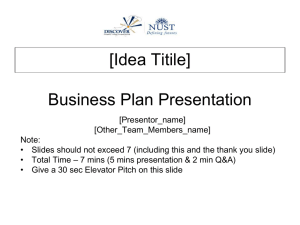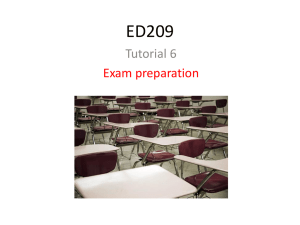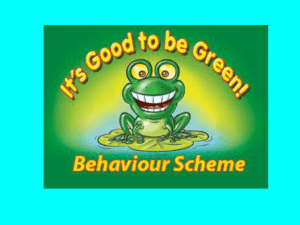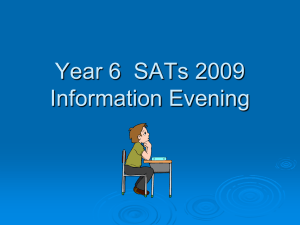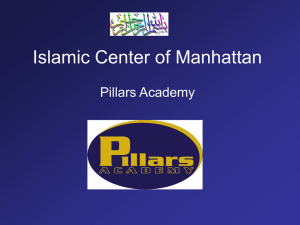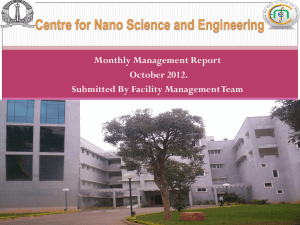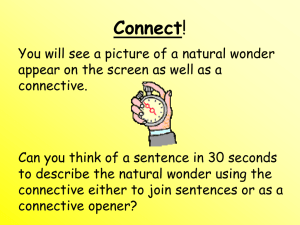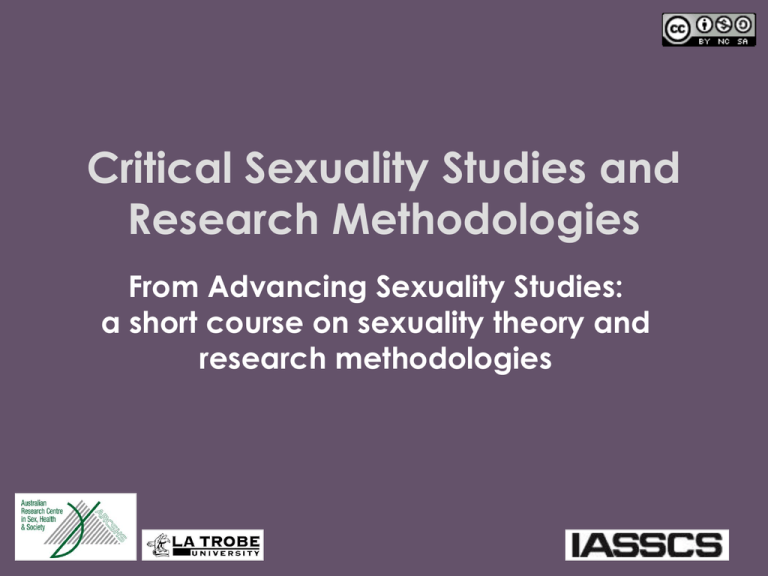
Critical Sexuality Studies and
Research Methodologies
From Advancing Sexuality Studies:
a short course on sexuality theory and
research methodologies
Schedule
Learning activity
Introduction & aims
Session 1. What is research? Key terms and concepts
Brainstorm & lecture
Pre-readings discussion
Mini lecture
Time allowed
5 mins
120 mins
55 mins
60 mins
5 mins
Session 2. Research matters in Critical Sexuality Studies
Lecture
Ethical issues: guided reading
45 mins
20 mins
20 mins
Session 3. Conceptualising and designing CSS research
Research design diagram & lecture
Group work
Lecture & brainstorm
Lecture & group work
Lecture & group work
250 mins
25 mins
65 mins
25 mins
80 mins
55 mins
Conclusion
Total
5 mins
425 mins
2
Module aims
• To introduce participants to key terms and approaches
within research methodologies
• To consider the intersections between ways of
understanding the world, methodology and field methods,
and the implications for Critical Sexuality Studies research
• To examine the research design process, from a Critical
Sexuality Studies’ perspective
3
Participants will:
• Develop an understanding of issues specific to conducting
research on sexuality, including the ethical, political,
cultural and social implications of sexuality as a field of
inquiry
• Obtain basic familiarity with how to design a research
project
• Be able to apply the principles of Critical Sexuality Studies
methodologies to the development of a research project in
co-operation with other members of the group
4
Session 1.
What is research?
Key terms and concepts
5
Brainstorm
• What research experiences have you had?
– Report back to whole group
• What might be a working definition of research?
(10 mins)
(10 mins)
(10 mins)
• Research: from 16th century French recerche / recercher
– To go about seeking
• A search or investigation directed to the discovery of some fact by careful
consideration or study of a subject; a course of critical or scientific inquiry
(http://dictionary.oed.com/) (OED online)
• … ‘research’ is probably one of the dirtiest words in the
Indigenous world’s vocabulary
(Tuhiwai Smith, [1998] 2008: 1)
6
Research methodology
The view of what constitutes a methodology … in the
context of social research is a contentious issue
(Sarantakos, [1993] 1994: 32)
… the logical principles underlying the organisation of … the
conduct of scientific enquiry
(Macquarie Dictionary 1981)
or:
The best means of acquiring knowledge about the world
(Denzin and Lincoln, 2005: 183)
7
A CSS understanding
• Within Critical Sexuality Studies, methodology is
understood to include ways of understanding the world
– Inextricably linked to ways of acquiring knowledge about the
world
• Methodology also includes the field methods one chooses
8
The complexity of knowledge
• Ways of understanding the world often presented by simplistic
division between:
Knowledge as objective
Knowledge as subjective
Existing outside of human
experience
Non-context dependent
Singular truth for each question;
fixed
Within the realm of human experience
Dependent on socio-cultural, historical,
political, emotional, experiential context
Multiple truths; shifting
• Most people hold elements of both, but preference one over the
other
• Knowledge as objective = dominant
9
Objective/subjective?
• Objective understanding of knowledge tends to lead to
quantitative research approaches:
– Counting what, who, when, where … to try and establish causal
relationships and patterns of association
• Subjective understanding tends to lead to qualitative
research approaches:
– Gathering opinions, beliefs, experiences, meanings to try and
understand the why or how of a research topic
10
Quantitative approach
• In general, a quantitative approach:
– Looks for causal or law-like explanations and descriptions of
patterns or association
– Focuses on data in numerical form, in non-natural settings
• Deductive: works downwards and inwards from a hypothesis
• Requires larger samples
– Look for generalisation through obtaining large sample size and predicting
majority trends (and differences)
• Main research method is survey/questionnaire
– Other methods include social network analysis
– Uses mainly statistical analysis to evaluate associations
11
Qualitative approach
• In general, a qualitative approach will:
– Seek in-depth and subjective understandings
• Focus on ‘rich’ or ‘thick’ description
• Smaller samples, in naturalistic settings
• Inductive: works upwards and outwards from specific observations to
broader generalisations and theories
• Looks for applicability of findings at socio-cultural process level
• Expectation that the researcher will be ‘reflexive’
• Many field methods, often in combination
– e.g. in-depth interviews, focus groups discussions, textual analysis,
participant observation, participatory action research
12
Comparison of quantitative and qualitative methods
Quantitative
Qualitative
Philosophical
foundation
Deductive, reductionist
Inductive, holistic
Aim
To test pre-set hypothesis
To explore complex human
issues
Study plan
Step-wise, predetermined
Iterative, flexible
Position of researcher
Aims to be detached and
objective
Integral part of research
process
Assessing quality of
outcomes
Direct tests of validity &
reliability using statistics
Indirect quality assurance
methods of trustworthiness
Measures of utility of
results
Generalisability
Transferability
Marshall (1996: 524)
13
CSS research
• Sexuality is an intersubjectively negotiated, social and
historical product
• Qualitative methods seen to offer the best framework for
interpreting sexual meanings, identities and categories
(Gamson, 2000)
• Approach and field methods chosen in any particular
research project will be influenced by the overarching
methodology
14
Pre-readings discussion
• Focus questions
– Kavanagh et al. (2002)
• What do the authors mean when they argue ‘we must begin to investigate
the process of research’?
– May (2001)
• What are the differences between positivism and realism?
• Why have feminist researchers been critical of science and social scientific
approaches to research?
(15 mins + 20 mins feedback)
• Brainstorm:
– In your experience, is one research approach given more
legitimacy than another? If so, why?
(20 mins)
15
Research design principles
• Well-designed research will:
– Show a clear link between the overall methodology, the research
approach and the field methods
– Be well thought through and have a precise focus
• What are the issues? Are the research questions well crafted?
• What do you want the project to accomplish? How might this be achieved?
• What dissemination plans or training might be needed?
– Meet with funding/grant application requirements
– Leave a ‘paper trail’, documenting all steps taken
– Be ethical
• What about anonymity, security, safety? For researchers and researched?
16
Session 2.
The importance (and
difficulty) of CSS research
17
CSS research: an overview
• CSS work is multifaceted and multidisciplinary, but:
– Always requires a focus on the shifting relationships of power,
knowledge, context, and culture
• CSS research tends towards qualitative inquiry
– Needs to be theory-driven, usually empirically inductive
– Many field methods, constantly evolving
• Capable of generalisation: processes, practices, social
dynamics (rarely population predictive)
18
CSS research: challenges
• Difficult field to research
– Site of secrecy, shame, stigma and discrimination
– Strong historical, political, legal and socio-cultural influences
• Complex relationship to other social phenomena, e.g. gender, social
class/SES, ethnicity/race, postcoloniality/orientalism, age/generation
• ‘Non-normative’ behaviours or identities often heavily policed by religious
and legal guardians
• Mandatory reporting requirements (e.g. knowledge of illegal acts)
– Ethical issues
• Human subjects research ethics
• Ethics and human rights
• Intrusiveness: public health imperatives vs. sexual rights/privacy
19
CSS research: challenges cont.
– Enormous breadth of possible research topics, often occurring on
a huge scale
• e.g. rape in war, teenage pregnancy, HIV
– Rapidly changing field, e.g. globalisation, commodification
– Cross-cultural challenges
– Dominance of public health approach
• Quantitative research with large sample sizes often considered more
legitimate than qualitative, small sample size research
• Continually perceived incommensurability between qualitative and
quantitative approaches and methods
• Reliability (replicability of findings) vs. validity (the strength of conclusions,
inferences or propositions)
20
CSS research: challenges
• Many different disciplines involved in sexuality research
– Particular disciplines or intellectual approaches favour
particular field methods and methodologies
•
•
•
•
•
Social sciences and humanities
Media and cultural studies
Legal studies
Women’s and gender studies
Educational research …
21
Does CSS research matter?
• Research can affect social change—knowledge is power
– It can be influential in encouraging and teaching the next
generation of sexuality researchers
– Effective, recognised research can lead to funding, career
development, publishing, teaching, tenure, etc.
• Institutional and professional roles are changed by research
– It contributes to the expansion of established knowledge
regarding an issue or topic
– It requires consideration of relationships and responsibilities
shared between researchers and the researched
22
Ethical issues
• Knowledge is power, but:
– Who owns it? Who gets to use it? Who holds the power?
– What is our relationship with, responsibility towards, and
negotiated understanding with, those we are researching?
– Requires reflexivity
• Guided reading
– Researching the Margins (2007) eds. Pitts and Smith, pp. 30-39
• Focus question:
– Obtaining official ethics approval is an ethical requirement of research. What
else might you need to consider, during the research process? (10 mins)
– Feedback (15 mins)
23
Session 3.
Conceptualising and
designing CSS research
24
Main steps in research design
•
Research is an
iterative, not
linear, process
–
The broad
‘segments’ of
a research
project
are:
Map the larger context & identify the key social
issue or concern to be researched
Define the specific research project
Fieldwork
Analysis
Develop research outputs, disseminate findings
25
Starting a research project
• Identify the key social issue or concern to be researched
(what to research) by drawing on:
– The larger context
– Broad research purposes
• What do we want to achieve? Why should we do this research?
– Crucial audiences
• Whom do we need to reach, target and inform in order to meet our
research purposes?
– Possible research outputs
• What might we produce, to reach our audiences and meet our purposes?
– Literature review
• What knowledge already exists? Where are the gaps?
26
Starting a research project cont.
• Define the specific research project
– Give it a title
• Make a statement about what you are trying to do
• Bring the research focus to the fore, through the title
• Don’t be obscure or too clever. Remember: keyword searches!
– Define research objectives
– Define your research questions
27
The larger context
• Research occurs within a web of interlinking fields:
– Political and social
• Are conditions favourable? What types of funding opportunities are
available, and what types of research are likely to get funded?
– Professional/academic
• Your work needs to fit the current agendas of industry, academia in
general, and your discipline in particular
• It should build upon and/or develop your own knowledge and expertise,
foster your interest and passion, develop your professional field or
discipline
28
Broad research purposes
• Consider:
– What is the larger social problem or issue to which your new
research project will make a contribution?
• e.g. gender-based violence, young people and sexuality, the media and
sexuality etc.
– What overarching impact do you hope this research will have
• Bearing in mind the interlinking fields in which the research will occur?
– Research purposes (or aims) should be ‘big picture’
• Preferably just 1-2 purposes
• e.g. ‘This research aims to broaden knowledge and understanding of …
and therefore contribute to …’
29
Crucial audiences
• Is it important that the research be done?
– To whom? For whom?
• Do you want to create change? If so, where and with
whom?
•
•
•
•
•
Academe, colleagues in field, theorists?
Government, policy?
Action, programs, practices?
Direct stakeholders, funders, agencies?
Respondents, communities?
30
Possible research outputs
• What would the research need to deliver, in order to reach
the crucial audiences and achieve the research purposes?
– Will you deliver a report, training materials, workshops?
– Might different types of audience require different types of
outputs?
– Producing different kinds of outputs affects what kind of data or
information your research needs to find
• Take note: this may change over the life of the project,
particularly if you undertake action research
31
The literature review
• Why?
– An expected part of grant applications
– Sets the stage, through assessing knowledge to date
• Knowledge of the social problem or issue, and of the larger context
• Knowledge of the methodological ‘habits’ or theories surrounding that
problem or issue, as well as of the larger context
• Knowledge of gaps in existing literature
– Enables identification of major players, theories, possible
publication sites, audiences
32
The literature review cont.
• How?
– Searching around a topic, not just within it
• Think laterally
• Develop an up-to-date reference list, with academic quality citations
(EndNote?)
• Annotate readings for key themes emerging as you go
– Online searching of databases, manual library searches
– Allow the literature review to evolve with the research project
• The literature review is the base on which academic
research is built
33
Specific project design
• Defining the specific project
– What is its title?
• Important to be clear, succinct and precise
– One project cannot research everything: what part of the larger
social problem or issue are you going to research?
• e.g. in the larger social problem of issue of young people and sexuality,
your new project will investigate: ‘the importance of sex education’ or ‘first
sexual activity’, or ‘experiences of sexual coercion’, or ‘beliefs about love
and romance’ etc.
– What are its specific objectives (sometimes called goals)?
• What is it that you want to do: e.g. ‘develop a better understanding of sex
education curricula’ , or ‘uncover new knowledge about first sexual activity’
34
Research questions
• Research questions
– Connection to theory
– Provide the focus for your research
• What do you seek answers to?
• Be succinct, capture the theory in the question, and limit yourself to 2-4
core questions
• Relationship between questions needs to be clear
– either sequential, additional or hierarchical
– Bear in mind the larger context and the project’s objectives
– Research questions formulated before you consider the field
methods
• Can be refined as methodology continues to develop
35
Types of research questions
• Either:
– Questions to be answered
or
– Springboard to development or reconstruction of theory
• Open-ended questions:
– Not causal or directional, use exploratory terms (explore,
discover, investigate)
• Closed questions:
– Seek to show causal link, look for definite answers (yes/no,
points on a scale etc.)
• Core question/s → subsidiary questions
36
Group work
• Teenage pregnancy & contraception case study (Handout A)
– Read handout
– Define:
•
•
•
•
•
•
•
•
(5 mins)
The overall research purpose
The crucial audiences
A specific research issue or problem
The possible outputs you might you aim for (based on the audiences)
The broad scope (and sites) for an initial literature search
The research project title
Your project objectives
Your project-specific research questions
(30 mins)
• Feedback
(30 mins)
37
Next steps
• Project design + methodology, approach, field method(s)
– No one Critical Sexuality Studies methodology, but all CSS
research is:
• Critical of objective claims to knowledge
• Attentive to the ways sexuality is invested with social and cultural meaning
in specific contexts
– Reviewing methodology and connections between research
design is part of the reflexive process
– Aiming for a methodologically coherent design
38
The practical aspects
• Based on your research questions:
– Where are you most likely to find the information (data) that will
give you answers?
– People tend to be central to finding answers in sexuality research
• As individuals per se, as types of individuals, and/or as specifically
nominated individuals
• Sometimes clusters of people are more important; for example:
–
–
–
–
–
–
Communities (e.g. a gay community)
Sub-cultures (e.g. artists)
Locales (e.g. a village)
Cohorts (e.g. 15-year-old girls)
People with distinguishing characteristics (e.g. people with disabilities) or
Patterns of association (e.g. military hierarchies)
39
Beyond people…
• Consider looking beyond people as such, and towards:
– Experiences e.g. particular events, places and times, certain issues
(health, sexuality)
– Processes e.g. institutions, relationships, interactions
– Practices e.g. drug-taking, sexual, social, educational, sport
– Ideas or concepts e.g. authority, hegemony, pedagogy, competitiveness,
stigma, racism, homophobia, sin, pleasure
– Useful research on all of the above could be carried out entirely
through secondary sources e.g. collecting and analysing documentation
40
Sampling
• Having identified your research ‘data source’ (people or
things), you need a sampling framework
– How big is your data source?
• If you are looking at 15-year-old schoolgirls, the number will be very large
• If you are looking at an organisation’s guideline documents, the number
will be relatively small
– Is it both feasible and necessary for you to involve all of your data
source?
• Does your approach call for a larger, statistically representative sample
size (quantitative) or rich narrative data (qualitative)?
• Do you want to generalise outwards from the data source, or do you want
to show relevance to a broader population?
41
Don’t forget…
• Decisions on who will be involved, and in what capacity,
should all be based on your research questions
– Supported by your literature review, research experience, key
informant information etc.
• Other players in the research process. These include:
– Those who control access to the research object (gatekeepers)
– Broader stakeholders (e.g. should there be an advisory group?)
42
Choosing field methods
• What is the most suitable method for obtaining the data or
information you require from your research data source?
– Decision will be based on:
• Experience (yours and others)
• Feasibility
– Budget?
– Staff?
– Time?
• Research purposes, objectives and crucial audiences
• Flexibility and reflexivity in the field
• Disciplinary specialities
43
Who uses which field methods?
Examples of research approach, method and disciplinary connection
Approach
Field method
Primary related discipline?
Qualitative
Participant observation
Anthropology
Textual analysis
Literature / media studies
Semi-structured, unstructured or
structured interview
Multi-disciplinary
Life stories / narrative theory /
genealogy
Sociology / history
Quantitative Structured interview
Multi-disciplinary
Survey
Epidemiology
Experiment
Psychology / sexology
Social network analysis (SNA)
Psychology
44
And then…
• Approach and field methods determine analysis options
– Thematic analysis, or statistical regression?
• NVivo or SPSS? Printouts and scissors, or a calculator?
– Large range of analytic approaches, again, often chosen based
on disciplinary preferences
• Regression analysis, multi-level analysis, analysis of variance …
• Critical discourse analysis, thematic analysis, content analysis …
– Analysis incorporated as an integral part of the research process
(action research)?
45
Ethical issues
• From the research design phase, begin to consider:
– What possible physical or emotional risks could arise during the
research process (including risk to the researchers)?
– What ethics processes will you need to go through?
• e.g. University, hospital, government department, national guidelines,
NGO/INGO…
• What requirements will you face?
– e.g. data storage, information to be provided to participants, nature of
informed consent, report back to those involved…
46
Ethical issues cont.
• All processes for ethical approval require you to have clear,
well thought-out rationale and methods for:
– Recruitment
– Gaining informed consent (written or oral)
• In addition, researchers need to reflect on their moral
responsibilities in terms of:
– Participant safety & minimisation of intrusion
– Promising confidentiality and/or anonymity
– Gaining consent
47
Beyond ethics approval
• Other ethical considerations:
–
–
–
–
Staff safety (physical and emotional)
Staff confidentiality agreements
Report-back provisions
Ensuring that publication or dissemination of research material is
ethically acceptable to everyone involved
– Your work will be peer-reviewed. Are there conflicts of interest?
48
Research design: a review
•
Iterative process
– Identify the key social issue or concern to be researched
• Pulling together the larger context, broad research purposes, crucial
audiences, possible research outputs, literature review
– Define the specific research project
• Give it a title, define your research objectives, project-specific research
questions
• Decide your methodology, approach, field methods, analysis method
– Undertake fieldwork
– Analysis
– Disseminate the findings (bearing in mind the crucial audiences
and overall research purpose)
49
Group work
• Returning to Handout A, review your research questions
and design to date then identify:
– People who might be involved in a research project, and how
• (Research data source? Gatekeepers? Advisors?)
– What research approach and field method(s) would you use?
– What particular ethical challenges might arise?
(30 mins)
• Feedback
(30 mins)
50
Proposals for funding
• Large variety of funding application formats
– Considerable variation in meaning of terms used:
• Methodology, method, field method, approach; participants, subjects,
co-researchers; aims, goals, objectives, purpose
– Common requirements:
• Research project title
• Background statement (social issue, brief literature review, theory, how
you got to this starting point for this project)
• A cohesive, coherent project conceptualisation and design
– Research purpose, objectives, research population/people involved,
sampling, ethical issues (and responses), approach, field methods, analysis,
research outputs, dissemination plan
51
Proposals for funding cont.
•
•
•
•
•
Administrative / organisational details, partnerships
Host or administering organisation
Details of project management and financial oversight
Budget and budget justification
Rationale for involvement of project staff members (based on their track
record)
• Procedures for ensuring ethically acceptable research
– Which ethics committees will you be applying to?
– What procedures will you put in place to minimise the potential of harm?
• Timeline
– All of which takes a great deal of time to complete
52
Dissemination
• A research project is not complete until the findings have
been disseminated effectively
– Effective dissemination means:
• Achieving the project aim by reaching the crucial audiences in appropriate
ways
• As and where appropriate, ensuring research participants (and other
gatekeepers/key informants) are kept up to date
– Crucial audiences could include:
• Funding bodies
• Involved professionals
• Professional associations
• Think tanks
• Activist groups
• Other researchers
53
Dissemination modes
• Different audiences, different modes of dissemination:
– Report (interim and final)
• Essential with most funding bodies
– Executive summary or summary of recommendations
• Useful with bodies that may fund future research
– De-briefing meeting(s)
• With project researchers and advisers
– Workshops
• With participants, activists or professionals
– Newsletters
• For participants, also for professional organisations
54
Dissemination modes cont.
• Other possible modes of dissemination:
–
–
–
–
–
–
–
–
Academic articles, professional journals, books
Conferences
Government briefings, funder briefings
Community events with key speakers
Training materials
Radio and TV, newspapers and magazines, media kits
ISBN/ISSN nos, electronic storage (e.g. list serves, repositories)
Legal deposit (e.g. national libraries, universities, Parliament)
55
Group work
• Returning to the teenage pregnancy and contraception
research case study, develop a draft dissemination plan
– Again, keep in mind your:
•
•
•
•
Overall research purposes
Crucial audiences
Specific project objectives
Project outputs
• Feedback
(20 mins)
(20 mins)
56
Conclusion
• CSS can be an emotionally (and occasionally legally)
fraught field to research
– it is also a valuable and highly important one
• Need for well thought-out, coherent research that adds to
our understanding of human sexuality within a social,
cultural, political framework
• Good research can facilitate social, cultural and political
change
57
• Module created by:
– Professor Gary W. Dowsett, Australian Research Centre in
Sex, Health and Society
– With input from Dr Sean Slavin, Ms Gillian Fletcher, Mr
Murray Couch, Dr Duane Duncan and Dr Jon Willis
• Short course developed by:
– The Australian Research Centre in Sex, Health and
Society, La Trobe University, Melbourne, Australia
and
– The International Association for the Study of Sexuality,
Culture and Society (IASSCS)
– With funding from The Ford Foundation
Available under an Attribution, Non-Commercial, Share Alike licence from
Creative Commons
58


